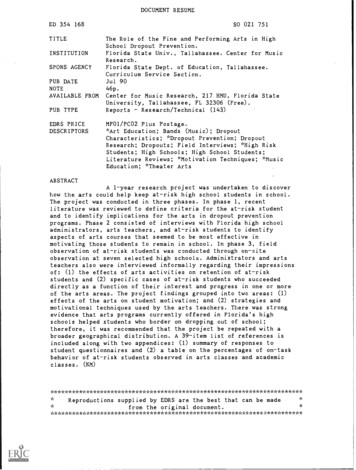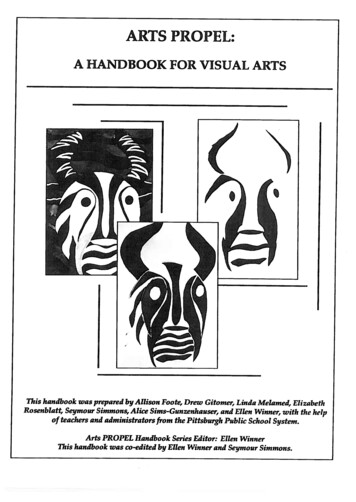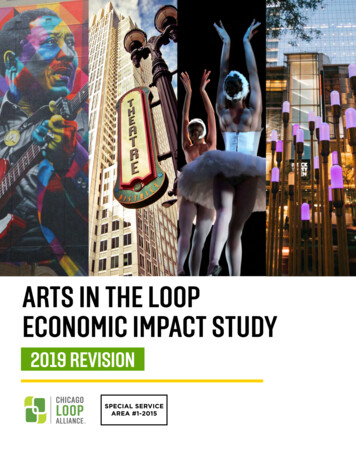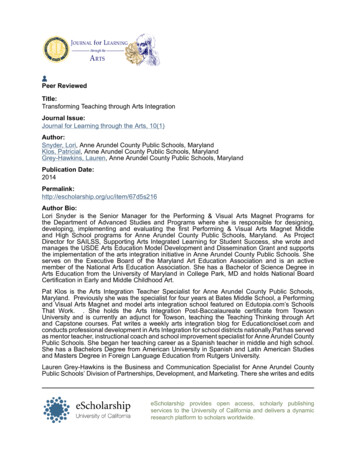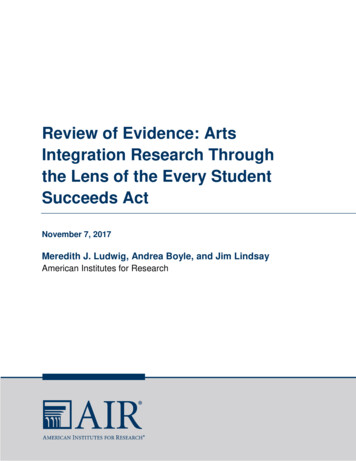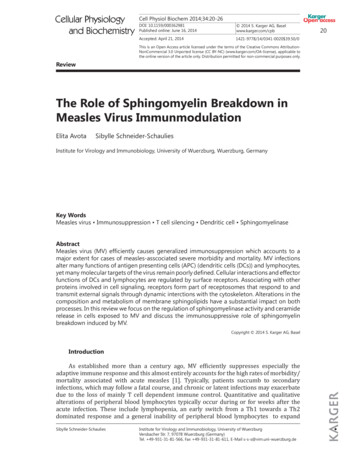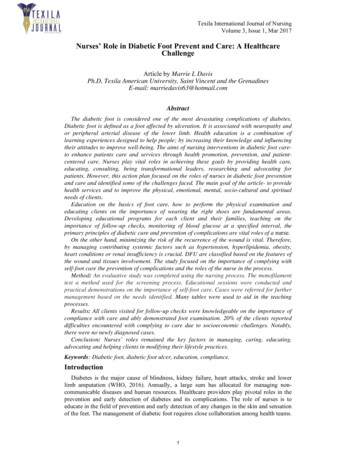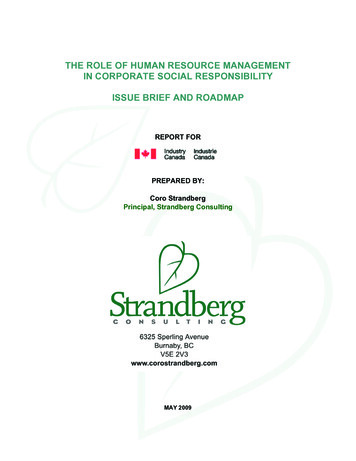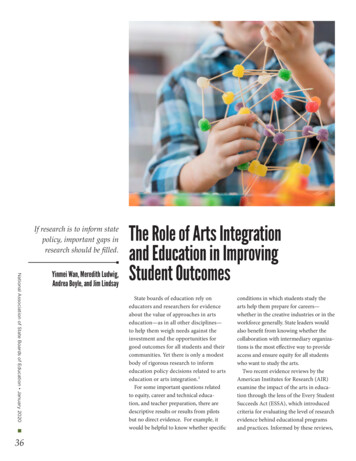
Transcription
If research is to inform statepolicy, important gaps inresearch should be filled.National Association of State Boards of Education January 202036Yinmei Wan, Meredith Ludwig,Andrea Boyle, and Jim LindsayThe Role of Arts Integrationand Education in ImprovingStudent OutcomesState boards of education rely oneducators and researchers for evidenceabout the value of approaches in artseducation—as in all other disciplines—to help them weigh needs against theinvestment and the opportunities forgood outcomes for all students and theircommunities. Yet there is only a modestbody of rigorous research to informeducation policy decisions related to artseducation or arts integration.1For some important questions relatedto equity, career and technical education, and teacher preparation, there aredescriptive results or results from pilotsbut no direct evidence. For example, itwould be helpful to know whether specificconditions in which students study thearts help them prepare for careers—whether in the creative industries or in theworkforce generally. State leaders wouldalso benefit from knowing whether thecollaboration with intermediary organizations is the most effective way to provideaccess and ensure equity for all studentswho want to study the arts.Two recent evidence reviews by theAmerican Institutes for Research (AIR)examine the impact of the arts in education through the lens of the Every StudentSucceeds Act (ESSA), which introducedcriteria for evaluating the level of researchevidence behind educational programsand practices. Informed by these reviews,
program, one part of the No Child Left BehindAct, comprised four components, including aModel Development and Dissemination Grantprogram and a Professional Development forArts Educators Grant program. Together, theseprograms supported well over 100 projects.2Then, in 2018, the department awarded 22 grantstotaling 12 million through the Assistance forArts Education Development and DisseminationGrants Program to support the development andsharing of arts-based instructional programming.ESSA has raised awareness about opportunities for the arts in education. Through itsemphasis on a “well-rounded education,” thelaw encourages states to include the arts aspart of that education (see also the article onpage 6). ESSA features at least a dozen fundingopportunities that can help support arts integration, which is a specific approach, set of activities, strategy, or program that links arts with atleast one other subject to improve student andschool-related outcomes. In addition, ESSAfeatures at least 10 opportunities to support artseducation, meaning a sequence of classes in agiven arts discipline taught by teachers certifiedto teach the arts (table 1).3we find that there are four kinds of gaps withcritical implications for state and district decisions related to the arts: gaps in research focus,where there is little or no rigorous researchabout a particular art type or outcome; gapsregarding size and type of populations participating in a program, such that the results of theresearch cannot be generalized to other schoolsettings, population locations, or makeup; gapsin recency and reporting, because the timingof the collection of data is not consistent withthe scheduled need or the results may not bepublicly available; and gaps in understanding therole of mediating factors that affect outcomes,such as location of the program, the studentfocus, or level of implementation.Federal Support for Arts EducationThis is an important time in which toexamine the role of the arts in education.Federal funding opportunities made availablein the No Child Left Behind Act of 2002 andthrough ESSA since 2015 have already seededlocal investments in arts education. The U.S.Department of Education’s Arts in EducationTable 1. Arts Integration versus Arts EducationArts education refers to artslessons or classes offered inprekindergarten through grade12 that are (a) standards basedand (b) taught by certified artsspecialist teachers or teachingartists through (c) an explicitor implied sequential artscurriculum in the (d) subjectsof art/visual arts, media arts,music, dance, and drama/theater.ComponentsArts integration interventionsinclude professionaldevelopment opportunities,the use of specializedpersonnel, the use ofspecialized instructionalmaterials, field trips, andwhole-school reform models.Arts education generallyoccurs in self-containedclasses taught by certifiedarts specialists. Arts educationmay vary in the expectationsregarding the level of studentperformance and may befocused on small groups,regular-sized classes, orindividual learners.Examples Students learn about circlesby painting them using arttechniques, using creativemovement to form circles withtheir bodies, and playing circularshaped musical instruments. T eachers use the process dramatechnique to help students learnabout inquiry in science andcommunicating about sciencetopics. R esearchers examined the effectsof dance education on students’creative thinking by comparingthe creative thinking ability ofstudents taking dance classeswith the ability of students nottaking dance classes. A drama intervention usesimprovisational techniques ina drama class to foster criticalthinking skills.Source: Authors' compilation developed from review of key documents, a logic model describing the types of interventions, and a review ofexamples of programs.www.nasbe.orgJanuary 2020 National Association of State Boards of EducationDefinitionArts integration is the practiceof purposefully connectingconcepts and skills from thearts and other subjects.37
According to a 2019 survey, school districtsare leveraging dollars available through thenewly created Student Support and AcademicEnrichment Grants program authorized underTitle IV, Part A of ESSA to support learning inthe arts. Nineteen percent of district respondentsindicated that they used Title IV, Part A dollarsto support well-rounded educational opportunities in music and arts education. The report ofthe survey indicated 92 percent of respondentsmade efforts to ensure that activities, strategies,or interventions purchased with these funds wereevidence-based, as defined by ESSA.4ESSA outlines four tiers for evaluating rigor inthe research base for a given program or activity (box 1). The tiers reflect a level of evidence:strong, moderate, promising, and evidencesupported by research-based rationale. ESSAencourages districts to choose programs that aresupported by evidence. For the arts, this can bechallenging. Variation in the quality and quantity of both the interventions and the associatedavailable research complicates the search forevidence-based interventions.Modest but Positive Student Outcomesfor Arts in SchoolsTo help policymakers and practitionersidentify arts-based strategies that meet ESSA’sNational Association of State Boards of Education January 202038“evidence-based” criteria, AIR conducted tworeviews of research examining interventionswhere the arts were taught or incorporated inpreK-12.5 Conducted from 2016 to 2018, theseevidence reviews examined reports of 44 artsintegration interventions and 87 arts educationinterventions with evidence in one or more ofthe four ESSA tiers. Each study included in AIR’stwo evidence reviews investigated the effect ofan arts intervention on a particular sample andset of outcomes.Among the arts integration interventionsreviewed, just 10 met the evidence requirementsfor Tiers I–III, including one that met requirements for the most rigorous tier, Tier I (box 2);the other 34 interventions had evidence in TierIV only. Similarly, among the arts educationinterventions reviewed, 17 met the evidencerequirements for Tiers II or Tiers III, and 70 hadevidence in Tier IV only (figure 1). As a finalstep, AIR analyzed the effect of arts integration across 27 well-designed, well-implementedstudies and the effect of arts education across 20well-designed, well-implemented studies.6Both evidence reviews found moderate,significantly positive impacts for students whoparticipate in arts integration activities andarts education classes, with an overall averageeffect size of 0.11 and 0.38, respectively. Thus, anaverage child could expect to gain 4 percentileBox 1. What Is an "Evidence-based" Intervention? (from Section 8101(21)(A) of the ESEA)".the term 'evidence-based,' when used with respect to a State, local educationalagency, or school activity, strategy, or intervention that —(i) demonstrates a statistically significant effect on improving studentoutcomes or other relevant outcomes based on —(I) s trong evidence from at least one well-designed and wellimplemented experimental study;(II) m oderate evidence from at least one well-designed and wellimplemented quasi-experimental study; or(III) p romising evidence from at least one well-designed and wellimplemented correlational study with statistical controls forselection bias; or(ii) (I) demonstrate a rationale based on high-quality research findingsor positive evaluation that such activity, strategy, or intervention islikely to improve student outcomes or other relevant outcomes; and (II) includes ongoing efforts to examine the effects of such activity,strategy, or intervention.
ARTS EDUCATIONARTS INTEGRATIONFigure 1. Number of Arts Integration and Arts Education Interventions by Grade Leveland Tier of EvidenceMIXED GRADE LEVELS (UP TO GRADE 12)ELEMENTARY AND MIXED GRADES (UP TO GRADE 8)EARLY ELEMENTARY (PRE K-2)TIER ITIER II-IIITIER IVTOTALMIXED GRADE LEVELS (UP TO GRADE 12)ELEMENTARY AND MIXED GRADES (UP TO GRADE 8)EARLY ELEMENTARY (PRE K-2)TOTALSource: Authors’ analysis of findings from literature reviews on arts education and arts integration.www.nasbe.orgGaps in Policy-Relevant ResearchResearchers seeking to enhance the rigorof studies about the arts and equity of accesshave encouraged states and districts to reportparticipation in and results of arts programs.7However, this recommendation is challenging to implement due to the limited types ofdata routinely collected, inconsistencies in howvariables are defined, and variation in the artscurricula from district to district.The two AIR evidence reviews highlight gapsin research evidence about student outcomes inthe four tiers by art type and types of studentoutcomes. Analysis of evidence gaps shows thatthe greatest number of interventions addressacademic outcomes, and the fewest address“other outcomes,” a catchall category thatincludes such things as school culture, teacherinstruction, and later-life success. A gap mapAIR prepared also highlights the difference inthe amount of studies of approaches by discipline: The greatest number emerged in musicand the fewest in dance.Recent data about students’ access to artseducation across and within states is hard tocome by. The National Center for EducationStatistics has produced overall snapshots, andResults in studentoutcomes differedmarkedly, both amongthe arts integration andarts education studies.January 2020 National Association of State Boards of Educationpoints in relevant outcomes as a result of participating in an arts integration intervention and15 percentile points as a result of participatingin an arts education intervention, based on theresearch reports we analyzed. An effect size of0.25 standard deviations (an improvement of 10percentile points) or larger is considered to be“substantively important” by the What WorksClearinghouse, a federal repository of evidencebased research on education.We also analyzed differences in the researchstudies’ reported impacts based on the type ofoutcome or the type of art discipline examined.Results in student outcomes differed markedly, both among the arts integration and artseducation studies and, within the arts educationstudies, by art types. For example, arts integration’s effects ranged from 0.11 for academicachievement outcomes and 0.91 for art learningoutcomes; the effects of arts education interventions across student outcomes ranged from 0.09for drama and 0.82 for visual arts. For some arttypes and types of programs, we were able toanalyze effects from only one study. Some effectswere positive, but not significant. Therefore,these findings should be viewed cautiously.39
Box 2. Research Providing Evidence at the Highest TierThese studies met Tier I evidence criteria and were cited as such in our report:Daniel H. Bowen, Jay P. Greene, and Brian Kisida, “Learning to Think Critically: A VisualArt Experiment,” Educational Researcher 43, no. 1 (2014): 37–44.Jay P. Greene, Brian Kisida, and Daniel H. Bowen, “The Educational Value of FieldTrips,” Education Next 14, no. 1 (2014): 78–86.Brian Kisida, B., Daniel H. Bowen, and Jay P. Greene, “Measuring Critical Thinking:Results from an Art Museum Field Trip Experiment,” Journal of Research onEducational Effectiveness 9, no. 1 (2016): 171–187, arch has notkept pace with thestakeholders’ needsfor policy-relevantinformation.National Association of State Boards of Education January 202040some researchers have mined longitudinal datasets to produce national pictures about artseducation access and outcomes.8 And there aredoctoral studies that make use of states’ administrative, school-based data on achievementand course-taking patterns to show correlationsbetween a variety of student outcomes andparticipation in the arts.However, data about student achievementin the arts lag behind the schedules for statedecision makers, and they are limited due tothe variation in offerings and participationacross the country. The most recent releaseof the National Assessment of EducationalProgress (NAEP) regarding arts participation and achievement in 2016 was necessarily limited to a focus on music and visual artsbecause only a small percentage of schoolsoffer students opportunities in dance andtheater. Furthermore, NAEP Arts found thatthe percentage of eighth graders in the UnitedStates taking music and visual arts stayed aboutthe same compared with data collected in 2008:63 percent were enrolled in a class in music, and42 percent took a course in visual arts.9 NAEPrecently reported plans to eliminate four assessments, including the arts, that had been reporting national-level data. Thus, state reporting onthe arts will be critical to assess the future of thearts in schools.Several states are making progress in theirefforts to identify a meaningful indicator aboutthe arts in their ESSA-required state reportcards, with 19 including arts within key areas oftheir state accountability systems.10Conclusion and RecommendationsThe past 30 years have seen an infusion offunds for program development and support forarts educators. For example, the Getty EducationFoundation has supported reform in teachingthe arts, the federal government has providedgrants for arts integration, and a particular focusfor investment has been arts integration forschool turnaround through the A Schools andTurnaround Arts models (see article, page 42).During this period, educational practice has alsochanged to incorporate the development and useof technology in arts teaching and learning. AndESSA created leverage points for states to improvestudents’ access to high-quality arts education.But research has not kept pace with thestakeholders’ needs for policy-relevant information. As national data become scarce andstate responsibility for accountability reporting continues, states will have an increasingresponsibility to invest in rigorous research andevaluations of programs. States and districtshave an opportunity to develop partnershipswith postsecondary institutions and independent research organizations to develop andimplement rigorous studies around the policyissues of access, accountability, excellence,engagement, and economic viability. We offerthe following recommendations on the implications for state board members who seek policyrelevant research.Encourage districts to gauge the theoretical and empirical support for arts integration
may not yet be supported by strong evidence—may be suitable for pilots and exploratorystudies as a jumping off point for innovation. Asdistricts consider investments in such programs,state leaders should require that school districtsbuild in an evaluation component. As a bodyof evidence becomes available because of localevaluations, successful programs will come tothe attention of more educators.Ask whether and how your state’s education department is collaborating with otherstates to design systems for collectingand sharing data on arts participation andachievement. As states work together to designmeasures of arts learning, they may, for example,discover approaches to improve data quality.The National Endowment for the Arts (NEA)and the Education Commission of the States’efforts to provide recommendations for statedata systems could, in the long run, lead to theuse of consistent metrics and access to comparable data for research studies. Decisions onthe nature and frequency of the data collectedlocally may have an impact on decision making.A focus on unanswered questions will lead toimproved programs and outcomes.Advocate for partnerships between independent organizations and researchers tosupport more rigorous research and thusstronger evidence for arts integration andarts education. Researchers can help providemore Tier I evidence (i.e., strong evidence) byusing a randomized controlled trial study design,including a large enough sample of participants,documenting the attrition of study participants,and providing sufficient details of analyses andfindings. Such studies require specialized, technical knowledge, which is available in researchorganizations, for example, such as the granteesof the NEA’s research labs initiative.In sum, further research is needed to understand the effects of arts integration and artseducation on specific types of educationaloutcomes and for different populations ofstudents. Various factors are present in eachstudy about the arts, such as type of art, programtype, mix of sample, and setting of the study. It isnot possible to say with certainty which factorsinfluence the effects that are documented. Thewww.nasbe.orgfindings are promising but indicate that additional direct evidence is needed, especially ifparticipation in arts learning is being examinedin the context of broad policy directions. n1Meredith Ludwig, Andrea Boyle, and Jim Lindsay,“Review of Evidence: Arts Integration Research throughthe Lens of the Every Student Succeeds Act” (Washington,DC: American Institutes for Research, 2017); YinmeiWan, Meredith Ludwig, and Andrea Boyle, “A Review ofEvidence: Arts Education Research through the Lens of theEvery Student Succeeds Act” (Washington, DC: AmericanInstitutes for Research, 2018).2Yael Silk, “A Decade of Federal Arts in Education Funding:Trends, Analysis, and the Story behind the First 10 Years”(Washington, DC: Americans for the Arts, 2015); Rose Goffand Meredith Ludwig, “Review of Literature: Lessons onAssessing Teacher Practice and Student Outcomes in ArtsIntegrated Learning Settings,” unpublished working paperfor the Wolf Trap Foundation for the Performing Arts, 2011.3Ludwig, Boyle, and Lindsay, “Review of Evidence”; Wan,Ludwig, and Boyle, “A Review of Evidence.”4AASA, “Summary of the 2019 National ESSA Title IV-ASurvey” (Alexandria, VA: AASA, 2019), https://aasa.org/uploadedFiles/Policy and 0219.pdf.5Ludwig, Boyle, and Lindsay, “Review of Evidence”; Wan,Ludwig, and Boyle, “A Review of Evidence.” The WallaceFoundation sponsored the evidence reviews as part of alarger group of reviews providing information that wouldhelp state and local educators identify and use promisinginterventions that meet ESSA program funding opportunities and evidence requirements.6Meta-analysis is a statistical tool that uses data from studieseven though the results may not be statistically sig
Model Development and Dissemination Grant program and a Professional Development for Arts Educators Grant program. Together, these . Recent data about students’ access to arts education across and within states is hard to come by. The National Center for
